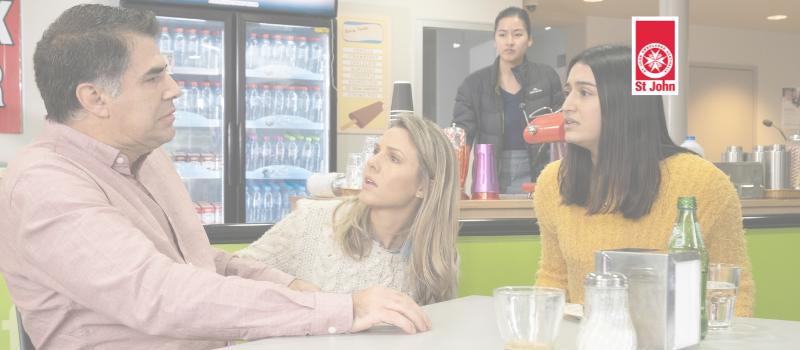DIABETES FIRST AID: HOW TO MANAGE THE SILENT ILLNESS

Around 1.7 million Australians have diabetes, this includes all types of diagnosed diabetes (1.2 million known and registered) as well as silent, undiagnosed type 2 diabetes (approximately 500,000). Currently, 300 Australians develop diabetes every day. That is one person every 5 minutes.
Diabetes has primary and secondary effects on those living with the condition as well as their loved ones. For every person diagnosed with diabetes there is usually a family member or friend who also ‘lives with diabetes’ every day to support. This means an estimated 2.4 million Australians are directly linked to diabetes.
Glucose levels that are too low (hypoglycaemia) or too high (hyperglycaemia) can quickly become a medical emergency where casualties can even slip into a coma. If you have a loved one living with diabetes, ensure that you are equipped with the First Aid skills and confidence in case of an emergency.
THE STATISTICS
The diabetic epidemic is no secret; most people know someone suffering from the disease, but just how many people does this illness affect and what does it mean for the wider community?

Source: Diabetes Australia
This condition poses a challenge due to its chronic nature, impacting individuals' daily lives and requiring diligent management to prevent complications.
WHAT IS DIABETES?
Diabetes is a chronic disorder of the pancreas. In simple terms, as part of the digestive process when food is consumed, the body works to break it down into sugars. The pancreas produces insulin to convert this sugar into energy. With diabetes, insulin is either not produced, or insufficient. This creates a build-up of toxins in the blood, which can be potentially life-threatening. Hypoglycaemia and hyperglycaemia are types of medical emergencies that can occur among people with diabetes.
THE DIFFERENCES BETWEEN HYPOGLYCAEMIA AND HYPERGLYCAEMIA
|
|
Hypoglycaemia |
Hyperglycaemia |
|
Cause |
Hypoglycaemia is when your blood glucose (blood sugar) levels begin to drop. It is the more common and dangerous type of diabetic emergency. |
Hyperglycaemia is when your blood glucose level starts to climb - it develops more slowly and can make a person ill over days or weeks. |
|
Signs and symptoms |
Weakness, trembling or shaking |
Excessive thirst |
TYPES OF DIABETES
Diabetes is broadly classified into two main types: Type 1 and Type 2.
TYPE 1 DIABETES:
- Cause: Type 1 diabetes is an autoimmune condition where the body's immune system mistakenly attacks and destroys insulin-producing cells in the pancreas.
- Management: People with Type 1 diabetes require insulin therapy for survival. This involves daily monitoring of blood sugar levels and insulin injections or use of insulin pumps.
TYPE 2 DIABETES:
- Cause: Type 2 diabetes is often linked to lifestyle factors and usually occurs later in life. It occurs when the body becomes resistant to insulin or when the pancreas fails to produce enough insulin.
- Management: Management includes lifestyle changes such as diet, regular physical activity, and sometimes medications or insulin therapy to control blood sugar levels.
DIABETES FIRST AID FOR AN EMERGENCY
It's a common misconception that someone experiencing hypoglycaemia might be intoxicated, as the symptoms can resemble each other. However, it's crucial to recognise that they could be on the verge of slipping into a coma. Always check for diabetes bracelets or tags and consider asking them directly about their condition. Even if there's a smell of alcohol on their breath, they may still be experiencing a hypoglycaemic episode. Additionally, alcohol can exacerbate hypoglycaemia in individuals with diabetes, making prompt assessment and intervention even more critical.
If a casualty is unconscious:
- Follow DRSABCD
- Call triple zero (000) for medical assistance
If a casualty is conscious and signs suggest hypoglycaemia:
- Follow DRSABCD
- Help the person to sit or lie in a comfortable position and reassure the patient
- Loosen any tight clothing
- Give the person sugar (glucose) such as a soft drink, fruit juice, sugar, jellybeans or glucose tablets
- Continue giving sugar every 15 minutes until person recovers
- If their next meal is more than 20 minutes away, give the person carbohydrates, such as a sandwich, milk, fresh or dry fruit, or dry biscuits and cheese.
- If there is no improvement in symptoms, call 000 for an ambulance
If casualty is conscious and signs suggest hyperglycaemia:
- Follow DRSABCD
- Encourage the person to drink water
- Seek medical aid if symptoms worsen
- If the person has not yet been diagnosed with diabetes, encourage them to seek medical aid
DIABETES ONGOING MANAGEMENT
Regardless of type, effective diabetes management focuses on:
- Monitoring Blood Sugar Levels: Regular monitoring helps individuals understand their glucose levels and adjust their treatment plans accordingly.
- Healthy Eating: A balanced diet rich in fruits, vegetables, lean proteins, and whole grains can help manage blood sugar levels.
- Physical Activity: Regular exercise improves insulin sensitivity and helps control weight.
Medications and Insulin: Some individuals may require medications or insulin therapy as prescribed by their healthcare providers to manage their condition effectively.

DIABETES AWARENESS AND SUPPORT
Diabetes is a challenging condition, but knowing when and how to provide first aid will provide both you and those affected with greater peace of mind. Continuing to educate ourselves and others about diabetes, promote healthy lifestyles, and support those affected by this condition will help them to life long and fulfilling lives.
Source: Diabetes Australia - What is Diabetes
